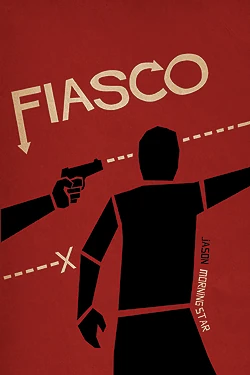Fiasco is a narrative game that constructs a two act narrative centered and driven by the player characters constructed through Fiasco’s set of varying prompts. Preceding the gameplay, is the setup, where players create their characters through the selection of responses falling under the categories of a relationship, need, location, and/or object. There’s additionally a “playset” preconfiguration to choose which dictates the subsequent theming of the prompts, and ranges from a wild-west town known as Boomtown or an icy science expedition fittingly labeled: “The Ice”. Either way, the setup and rules promise an environment of crime, debauchery, and dramatic events that provide the tools for the players to create their roleplaying persona and construct the scenes that make up each act. Despite being only a small part of the overall playtime, it’s important to not neglect the setup phase, as the elements established during this scene are integral for creating the basis for scenes, with the rule book actively encouraging players to stick with what is established already and largely stick to the use of these elements.
If the gameplay involves players roleplaying to create a narrative, then the mechanics that Fiasco provides to support this can be understood in two ways: the tools to create the scene (which we covered in the setup), and the outcome resolution: leaving the player establishing the scene uncertain of its outcome while still maintaining control of its implementation. This outcome resolution manifests itself through the process of choosing whether to establish or resolve a solution–the player whose turn it is chooses the where and what of a scene and the other players choose the outcome, good or bad (and vice versa if the player chooses to resolve a scene). In this way, Fiasco provides the tools for a variable process of building a narrative and enabling the input of all players. The actual systems themselves are rather simple, with the bulk of the rulebook providing advice towards the players and attempting to get them in the mindset of their character, and the story they will create. There’s the additional system of dice collection and the tilt selection in between acts 1 and 2, but these largely just add additional details for handling the central conflict of the story and the final outcomes of the story.
So, how does the Fiasco system hold up in its entirety? For a TTRPG that’s far shorter than some of its epic-length competitors, the narrative constructed in Fiasco is not one filled with gradual worldbuilding or a great and complex villain. Players jump right into the story with a general consensus in how the world operates, and the playset used ends up shaping much of the dynamics. After allowing the players the time to build up the story with the first act, Fiasco then introduces further elements in the ‘Tilt’ which provides the basis for how the climax in act 2 can be done. Then finally, in the aftermath, the players who have been the most extreme drivers of the story end up with the most positive outcome, regardless of whether they caused ‘bad’ or ‘good’ for other players. Overall, what I like most about Fiasco’s preset systems is how it provides a simple and easy method for establishing a player’s character and the dynamics in the world. As opposed to other systems that rely on more preparation work from the GM, this allows Fiasco to have a fluid and quicker approach to components. However, the other side of the system, the logic resolution of the game’s mechanics feels somewhat lackluster, where other TTRPGs have harder rules and more variance, Fiasco is merely just the rest of the party’s decision on how an outcome should go, in a binary that is open to interpretation. Perhaps overall this lighter system works in conjunction with the Fiasco package: presentable as a shorter and generally more approachable TTRPG, albeit lacking in comparison to some of the more complex and diverse worlds of other advanced systems.
